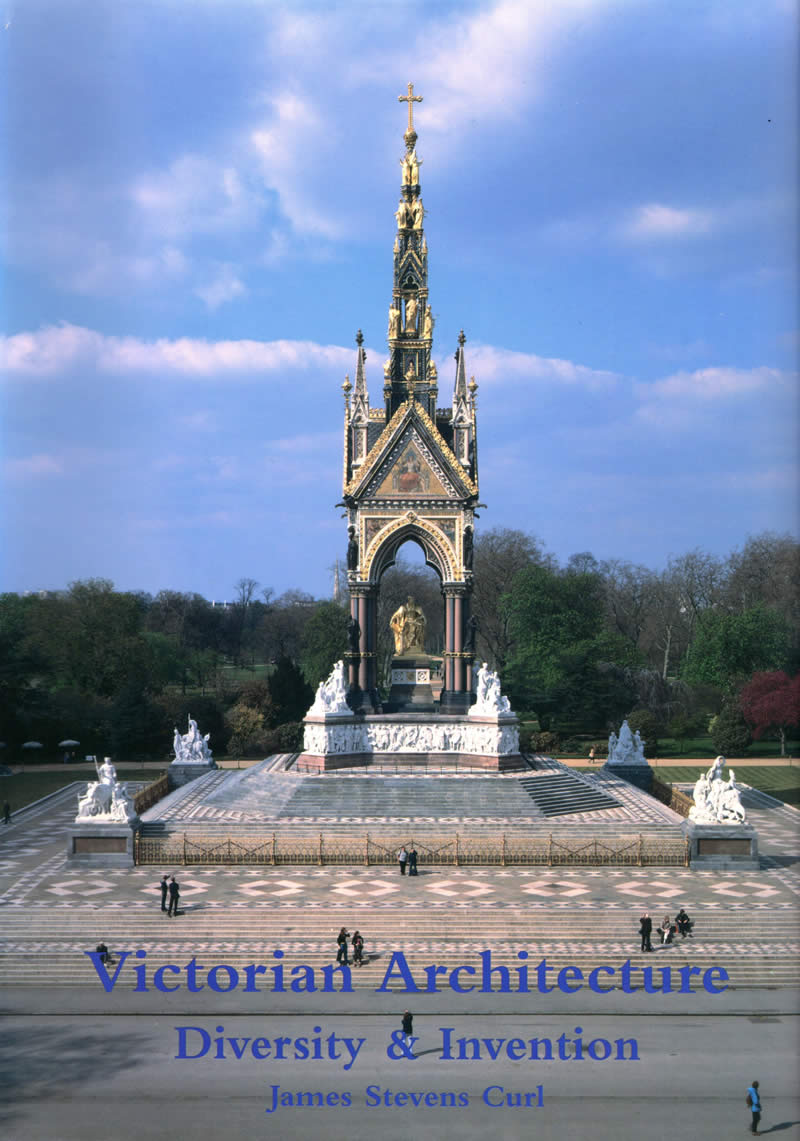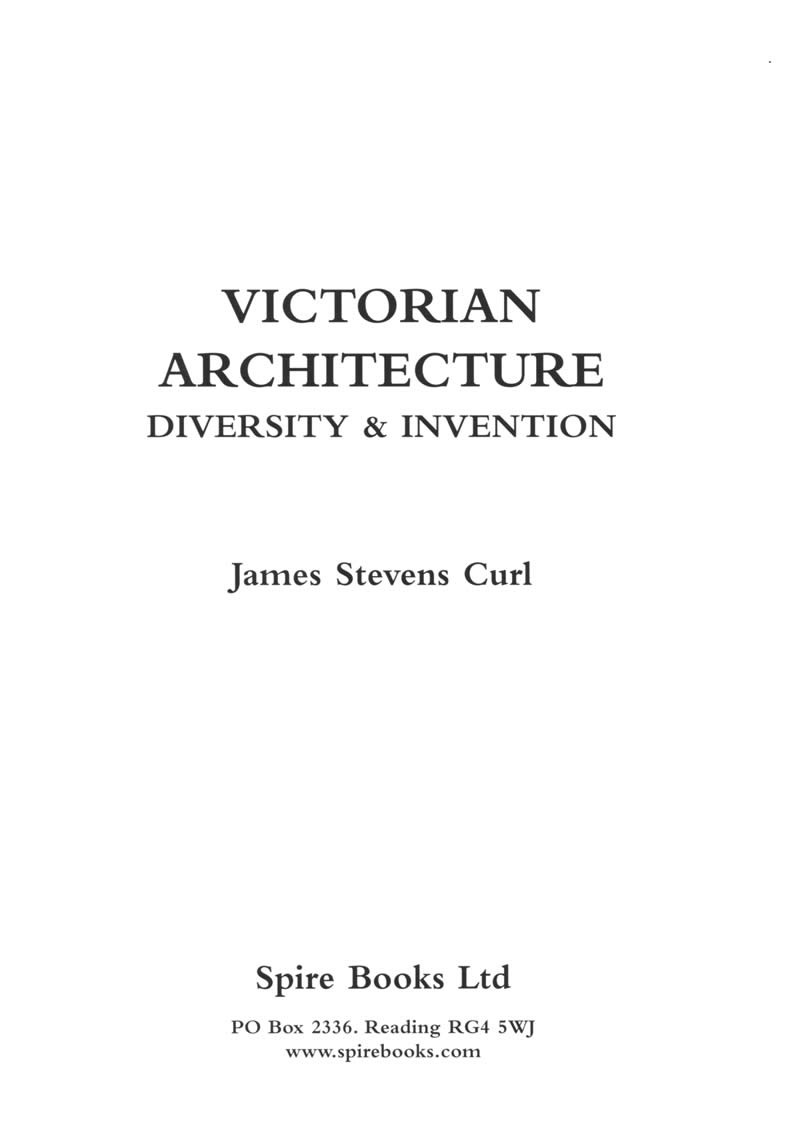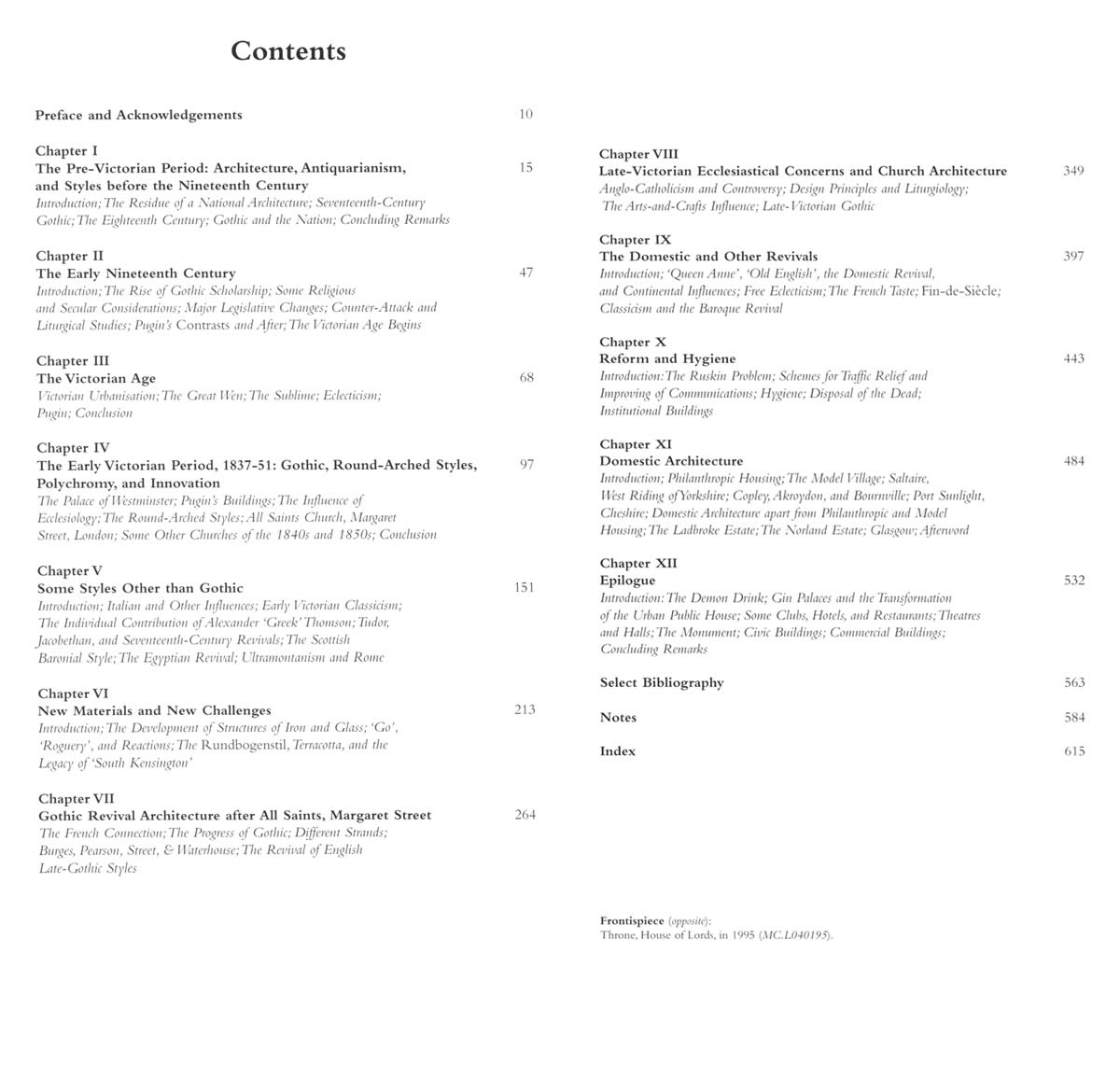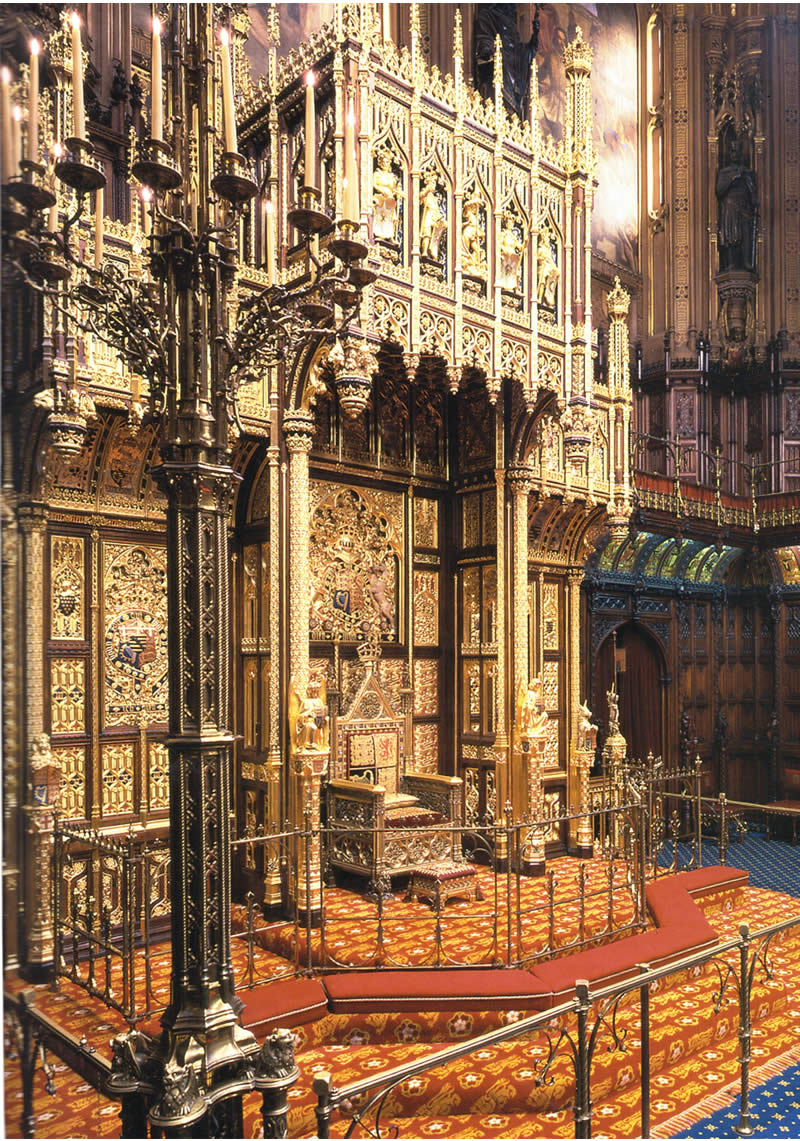Victorian Architecture: Diversity & Invention

Author : James Stevens Curl
Publisher : Reading: Spire Books, 2007
ISBN: 978-1-904965-06-0 (hbk)
Many buildings erected during the Victorian Age had no precedents: railway-stations, large hotels, and factories all marked a new period of rapid and intensive change. New structures had to be planned from first principles, and architectural styles were adapted, representing the Victorians’ dual concerns with aesthetics and practicality. By means of a wide-ranging collection of illustrations and a text recognised as authoritative, the great architectural achievements of an Age which responded to unprecedented challenges and opportunities with confident, colourful, rumbustiously eclectic buildings are brought to life. This massive book deals with the palette of styles available to the Victorians; entirely new building types; novel materials; ecclesiastical buildings that, arguably, were superior to mediaeval exemplars; the responses of a vital society to contemporary challenges; and how the Victorians went further than anyone since Roman times to potty-train Urban Man. All this is set firmly within the context of the intellectual complexities of the Age, illuminated by jargon-free prose, bringing the Victorian period to life in a work which will give readers much to ponder, savour, and enjoy.
Earlier, much less comprehensive books on Victorian architecture were:
Victorian Architecture (Newton Abbot: David & Charles Publishers plc, 1990, ISBN: 0-7153-9144-5 [hbk. & pbk.]); and
Victorian Architecture; its Practical Aspects (Newton Abbot: David & Charles (Holdings) Ltd., 1973, ISBN: 0-7153-6027-2 [hbk.]).
Reviews
‘It is some time since there has been a major book on Victorian architecture. In this weighty and magnificently illustrated volume, Curl brings together many of the subjects he has studied throughout his professional life... He starts … with an excellent account of the Gothic Revival ... His defence of Butterfield against any charge, especially that of ugliness in his work ... is impressive... He does not find Ruskin’s influence helpful and is not afraid to say so... He writes well...The illustrations are, of course, a most important element in Curl’s arguments and they form a particularly well-chosen and generous collection.’
‘One that stands independent of the Hegelian tendency and the lure of the Zeitgeist is...James Stevens Curl....Victorian Architecture represents a lifetime's reading and research and the contents of Curl's filing cabinets have been poured into a volume on an unequalled scale of comprehensiveness.... He has triumphantly surmounted fastidious ideological reservations by presenting the Victorian architectural achievement as it was.’
‘What makes this book so valuable and, particularly where church architecture is concerned, so definitive, is the combination of superbly professional photography with a text that is as intelligently critical of A.W.N. Pugin and John Ruskin as it is of Nikolaus Pevsner. To be even-handed where those three notably prolix and self-assured writers are concerned marks Curl down as a scholar who has read everything relevant, visited everything worth noting, but then has stood back and absorbed the period with a Christian sympathy for Victorian motivation that few architectural historians today can offer. It is unlikely that a wiser judgement on building in Victoria’s reign will ever be written.’
‘The architecture of this splendid book—its structure, design, form, and articulation—is as illuminating as its content. The history is everything we would expect from its author, as he covers his period with a rigorous respect for the scholarship within which this history sits…. All is enlivened by pertinent and beefy illustrations with full references as to subject, source, date…. This rigorous framework is then varied just enough between and within chapters to ensure clarity and comprehension, so that even the most summary scan will bring the reader some beneficial enlightenment…. The book has the character of a uniquely serviceable reference… Indeed, this is a history book that, for all its substantial weight, is assertively accessible, a character deriving not a little from its reliance on all the good sense and media-savvy ingenuity that secured such high profiles for Pugin, Ruskin, and similar popularists of that age….We rely …on the enthusiasms of encyclopaedic specialists such as Professor Curl and other grand masters of British architectural history….to help understand, and defend, the true value and potential of our built heritage. This history is peppered with an awareness of how much we have lost, and could have lost…. Historically self-aware, logical, polemical, authoritative,…. it is necessarily a small summary of a very big age…. [Curl] makes the case brilliantly for Victorian architecture, and in many ways this most manageable of books….is a summation of how far the popular appreciation of Victorian architecture has progressed over a generation …[This] is… a splendid and engaging resource..., a unique meeting of diversity and accessibility.’
'Curl...[was] one of the earliest to bring our attention to the splendours of the Victorian way of death, almost four decades ago...He was also among the heroic generation of conservationists who found endless fascination in the Victorian way of building. This...book is his third on the subject, and is an epic undertaking ... As well as being a celebratory book, this is in places an angry book too: angry at the destruction of so many fine buildings; angry at the self-satisfied modernism which has taken its place; at the lack of respect given the endeavours of our forebears....There is nothing bland about this book: its praise is fulsome, and its criticisms are stinging... And ... its authoritative stature cannot be questioned. For once, it covers Britain, rather than England...This is a truly substantial book too: a heroic publishing achievement, in that so many illustrations have been reproduced within such a lavish format. And what pictures!...All are finely reproduced, resulting in a volume that is meant to last....Dissecting dreams, and identifying just what the sources were, is another of Curl's great strengths. It takes an extremely good grasp of European architecture to spot all of the allusions... Authoritative, extensive, beautifully produced, opinionated, scholarly, brisk, compendious: this is no ordinary book. By bringing so many buildings to our notice, and by so masterfully laying out the intellectual and architectural context for our contemplation, our appreciation of the Victorian building scene is considerably enriched. A special volume, all in all, and one that deserves every success.'
‘The rich textures of the built environment of the nineteenth century are gradually being re-evaluated and rescued. Curl's huge survey of Victorian architecture will contribute to that process; Curl has spent a lifetime studying the period, and his eye is finely trained to the subtle stylistic varieties of an iron rood-screen or a mullioned window. Prizing diversity and ingenuity, he offers a chronology of both religious and secular architecture that includes useful summaries of the pioneering work of many architects whose names have been as neglected as their buildings... He rehearses the permutations of the Gothic Revival in great detail, but also makes illuminating contrasts with lesser Classical, Romanesque, and Baroque Revivals, and with developments in structural engineering. The illustrations are copious ... [The] scope of this book remains impressive...’
‘This comprehensive work combining scholarship with imagination…is a liberal education in itself…Curl’s passion for the whole Victorian achievement shines throughout… It is a vast and magisterial work which it is hard to imagine ever being superseded.’
‘This…is…a timely and welcome publication. Here is a comprehensive study and wide-ranging showcase for the British architecture of this period of rapid and unprecedented industrialisation, wealth creation, and urbanisation. There can be few better qualified architectural historians to compile a volume such as this… It is clear that the publication represents a life’s work in examining the built legacy of the Victorians, born out of a fascination and love for it on the part of the author. Sharing it is an act of generosity. The wealth of photographic documentation presented, along with the lengthy bibliography, extensive notes, and detailed index make this a superlative work of reference. As for the text, it is authoritative, detailed, and impressively cross-referenced while achieving an enthusiastic tone which makes it accessible to the general reader as well as the student or professional. … The book is well organised … a remarkable contribution to architectural publishing ….for sheer range of coverage and reference photographs it is hard to think of a more impressive survey.’
‘Professor Curl, an unquestioned authority as an architectural historian and in many fields an expert without equal, is deploying with the publication of this massive book a major weapon in the current realignment of forces: his is an ambitious vision that stretches across the era, and his book aims to become the standard work of reference in which every major building is definitively placed in its historical context...it is about time that general reference books on Victorian architecture stopped being lists of things and started being more assertive...[This] book is a significant advance on earlier surveys. First, the Pugin revolution underwrites the whole thing; for all the many architects and buildings discussed in detail here, this is really a book about what Pugin did. Secondly, and this is one of the book’s strongest features, the information is presented in a combination of the chronological with the associational: architects are often presented as members of a group with shared interests, values and preoccupations. That means, for example, that museums find themselves alongside churches because the common theme is not the building type but architects’ attitudes to new forms of construction. That’s an excellent innovation. Thirdly, you will discover many unfamiliar buildings, often signalling Curl’s expertise in varied fields: Northern Ireland; Kensington; churches; cemeteries. Finally, there are fabulous illustrations ...[Curl’s] book is a monument: the kind of monument that a decent Victorian builder would have been proud of.’
‘Curl’s new volume on Victorian Architecture has found a happy spot on our bookshelves – lavishly illustrated, splendidly written, and magisterial in scope, it is a joyous testament to the notion that architectural historians never retire: they just become more practised in their art. The campaigner in Curl remains as strong as ever... He captures the excitement of the new materials and the brilliant way Victorian architects put them to use... At 636 pages this is a seriously hefty tome...which amply illustrates the diversity, creativity, and skill of Victorian architects, coloured with some wonderful personal insights....’
‘This book is in every way a weighty volume…, but it is worth every penny and can fairly be described as a bargain at the price. It is a magnificent, major achievement of scholarship and learning, written with grace and authority. It is the distillation of a life’s work, and like all the best of intellectual endeavour it is open and available to all, scholar and general reader alike …Curl is one of the most distinguished and most consistently readable of architectural historians. He has a string of significant books to his credit, but few, if any, surpass this magisterial survey of Victorian architecture, civic, domestic, and ecclestiastic….Here he offers a representative selection of important buildings, judiciously chosen, which capture the age in vivid detail. He is surely overly modest when he describes his work as a “mere introduction”: it is much more than that. It is an indispensable guide, a definitive companion for anyone interested in the art and culture of the Victorian Age…. Curl’s preface, in its assured epigrammatic persuasive force, rescues Victorian architecture from ill-informed prejudice, misconceptions, gross ignorance, untutored perceptions, populist taste, and haut en bas philistinism: of all of which he is suitably scornful. He precisely identified the problem: “International Modernism was more like a religion…and woe betide those who did not conform to its rigidities or swallow its tenets.” The modernist architectural movement was Stalinist in its ideological grip, imposing a philosophical straitjacket, stifling opposition voices, dismissing those with the temerity to see value in Victorian architecture to an aesthetic Gulag. … The hallmarks of the modernist movement were its social engineering and its dehumanizing philosophy of the collective rather than of the organic community. Why are there so many social problems, so much social dislocation in mid-twentieth-century conurbations? Circumspicere….In this book is the Victorian Age in all its architectural glory. The pages almost glow. The buildings are described with zest and the illustrations are perfection, wonderfully reproduced in sharp and clear definition. There is a detailed critical apparatus to satisfy the scholarly reader, an exhaustive and detailed index, and a text accessible to all. The whole production is….[a]….triumph for ….the most meticulous and conscientious of architectural publishers…’




 LinkedIn
LinkedIn  Wikipedia
Wikipedia